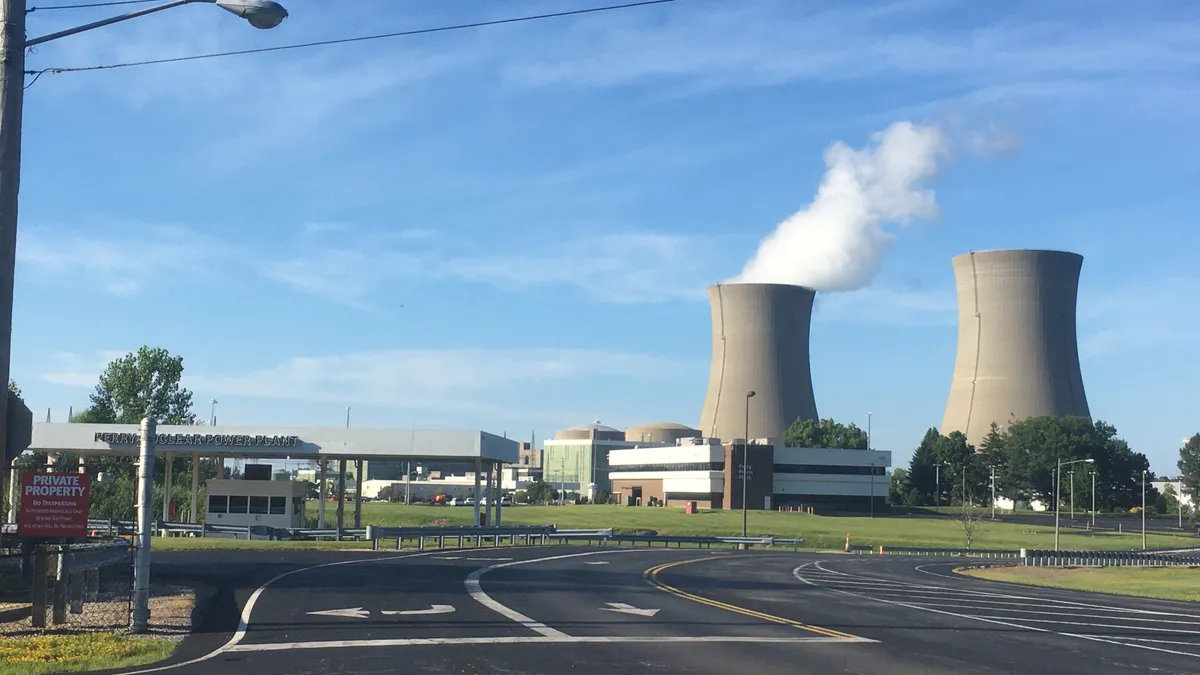Dive Brief:
- Lawmakers and regulators must do more to build momentum for the U.S. nuclear industry following the enactment of the ADVANCE Act this summer, according to a Sept. 26 panel at the National Clean Energy Week conference in Washington, D.C.
- Panelists from Constellation Energy, Oklo, the Nuclear Energy Institute and Idaho National Laboratory discussed opportunities to eliminate unnecessary steps in the reactor licensing process, expand federal support for serial reactor deployments, expand the U.S. nuclear workforce and craft regulations that allow existing nuclear generation to support data centers and hydrogen producers.
- Existing nuclear sites could hold the key to expanding the U.S. fleet in the near term, per a Sept. 3 report from the U.S. Department of Energy that found 41 U.S. nuclear sites were each potentially suitable to host at least 600 MW of new capacity, said panelist Brad Williams, senior policy advisor for Idaho National Laboratory.
Dive Insight:
Williams opened the discussion by noting the shift in the U.S. nuclear industry’s fortunes since last decade, when competition from cheap natural gas generation forced a spate of premature nuclear power plant closures. Now, retired reactors in Michigan and Pennsylvania are set to reopen in 2025 and 2028, he said. The owner of a third, in Iowa, has publicly floated following suit.
Constellation is able to spend $1.6 billion to restart the idled 835-MW reactor at Three Mile Island Unit 1 because Microsoft needs a prodigious amount of clean, 24/7 electricity to support its data center buildout, said panelist David Brown, Constellation’s senior vice president of federal government affairs and public policy.
Microsoft will purchase power from the renamed Crane Clean Energy Center for 20 years, and Constellation plans to apply for a license extension that will allow it to operate through at least 2054, Brown said.
Thanks to policy support from the ADVANCE Act, Constellation could add about 1,200 MW of additional capacity through equipment uprates within its existing fleet, or nearly half the 2,500 MW of uprate projects NEI says are under development across the U.S., Brown said. The U.S. Nuclear Regulatory Commission is looking to streamline its regulatory processes to enable reactor uprates, restarts and license extensions out to 80 or perhaps even 100 years of operation, he added.
Yet all panelists said that the industry needs more help from regulators and federal policymakers to speed up reactor deployments amid rising power demand from data centers and economy-wide electrification.
“If we are going to win the AI race — and we have to, because we can’t let China win it — we have to build reactors faster,” Williams said.
The NRC’s pending technology-inclusive, risk-informed Part 53 reactor licensing process rulemaking, which may not be ready until 2026 or later, “is just not on our radar,” said panelist Marcie Haber, director of federal affairs for Oklo, an advanced nuclear technology company.
“We have been on the Part 52 pathway for multiple years and we are full steam ahead there,” Haber said. Part 52 is a single-step process through which applicants receive a combined operating license, in contrast to the two-step Part 50 process that requires separate construction and operating licensing applications.
Part 52 aligns better with Oklo’s build-own-operate business model, Haber said. Some advanced nuclear technology companies, such as NuScale, instead plan to deploy reactors through development and operating partners.
Other early-mover advanced reactor companies are “not waiting for Part 53” either, said panelist Kati Austgen, senior project manager for new nuclear at NEI. The NRC, which recently granted construction permits for research and test reactors, is evaluating the construction permit application for TerraPower’s 345-MW Natrium demonstration reactor and has a number of other construction permits in preapplication review, she said.
Federal policymakers could help streamline NRC licensing by directing the commission to eliminate requirements for uncontested mandatory hearings, a reactor safety advisory committee that largely duplicates NRC staff work, and a requirement that licensing applicants collect their own weather data at proposed reactor sites, Williams said.
“The NRC makes applicants collect [weather] data instead of relying on the government agency responsible for monitoring the weather,” he said. “How does that make sense?”
Other federal agencies can bolster the nuclear industry’s momentum as well, panelists said. For example, the U.S. Department of the Treasury’s final rule on the Inflation Reduction Act’s Section 45V clean hydrogen tax credit should allow existing sources of clean power generation to qualify, including nuclear, Brown said.
In the private sector, industries that stand to benefit from access to clean, firm power should step up collaboration with the industry to bring more projects to fruition, Haber said. The Microsoft-Constellation deal “[is] a great step forward and we need more of that,” she said.
But deploying new reactors at scale requires a significant expansion of the energy workforce across more than 30 disciplines, Austgen said.
“We use more than just nuclear engineers,” she said.
The workforce that built Plant Vogtle units 3 and 4 has moved on to other projects and can’t immediately be called back, Williams noted. As the NRC licenses new reactors and developers break ground, the industry needs to coordinate serial construction so they can efficiently move from one project to the next, he said.














